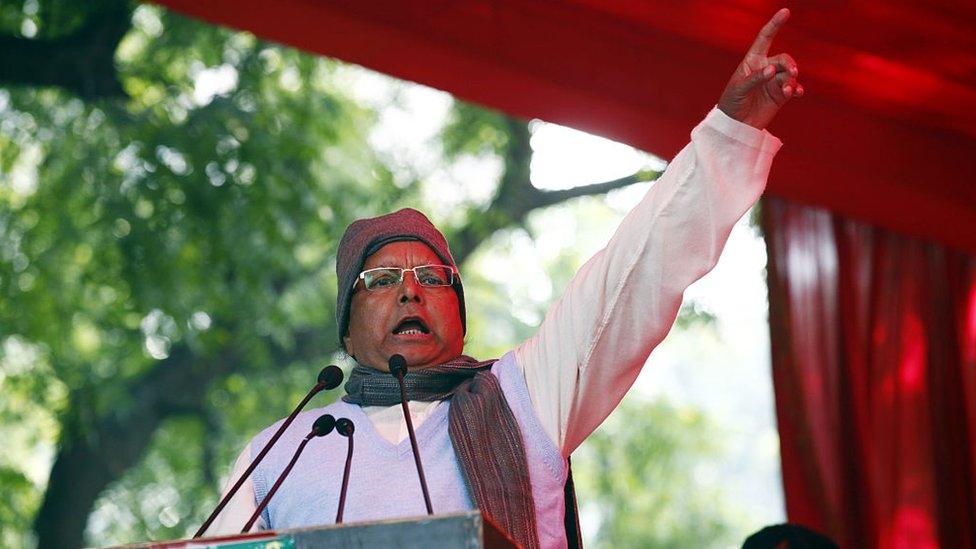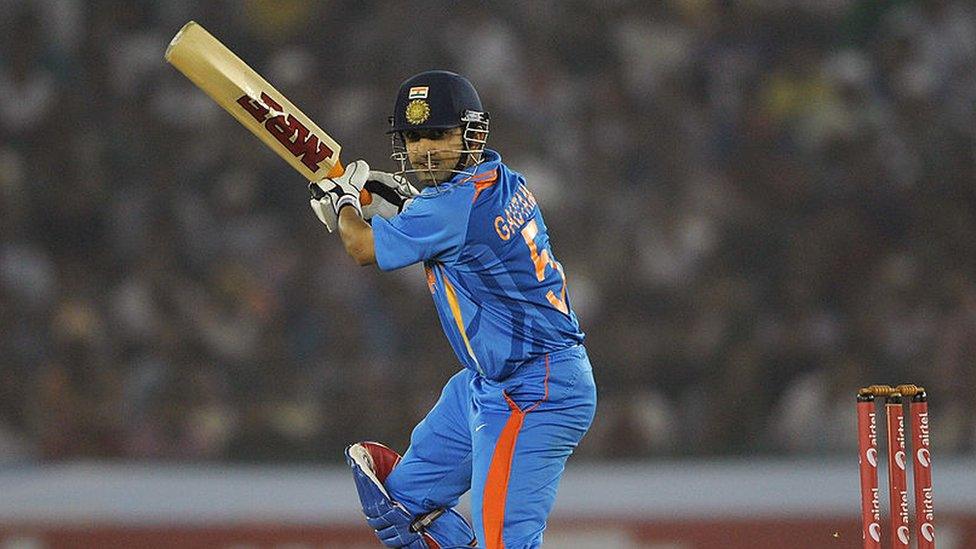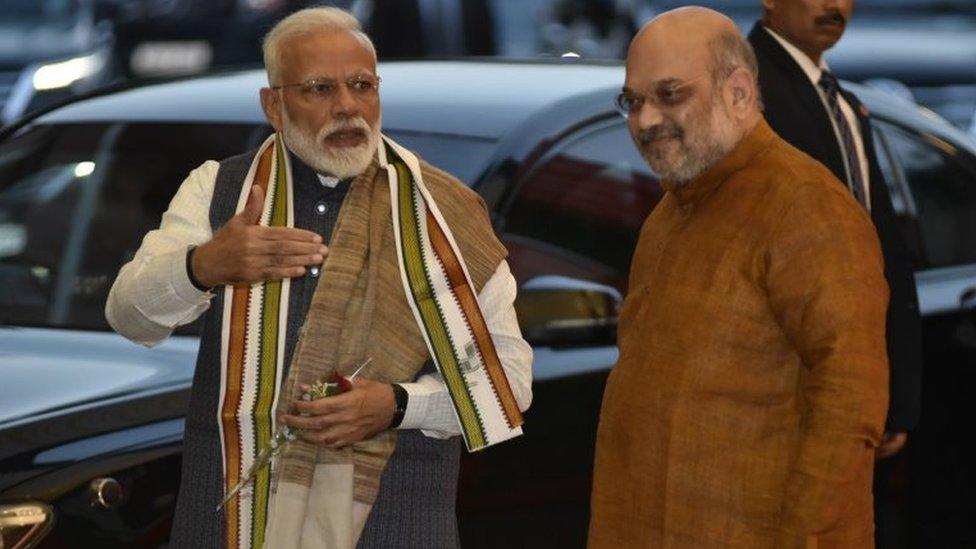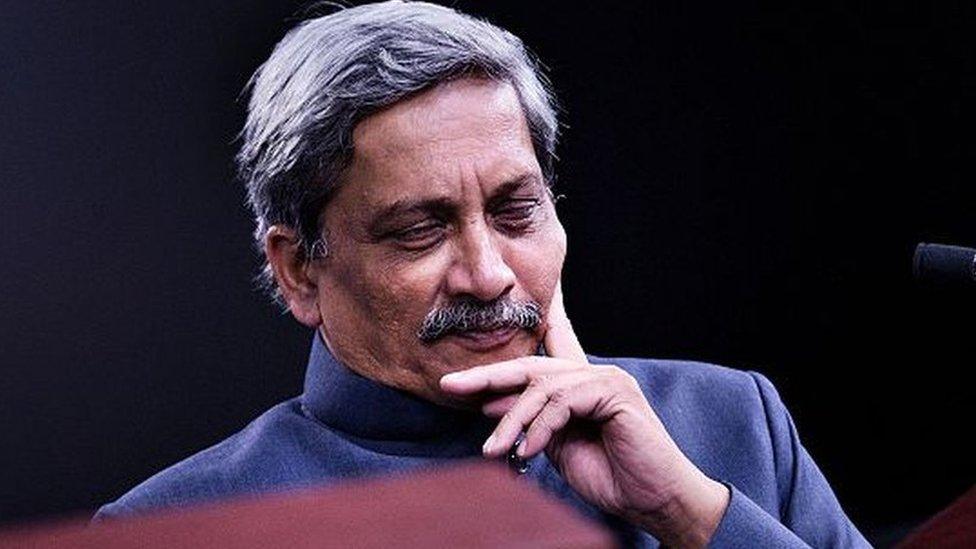India election 2019: The week that was 18-22 March
- Published

Lalu Prasad Yadav founded the RJD
India has entered full election mode: voting is due to begin on 11 April, with the final ballot cast more than five weeks later on 19 May. Every day, the BBC will be bringing you all the latest updates on the twists and turns of the world's largest democracy.
The latest from the campaign trail
A winning alliance?
What happened?
The main opposition Congress party have just announced an alliance with Rashtriya Janata Dal (RJD), a political party based in the northern state of Bihar.
Following negotiations, the two parties made the announcement on Friday. The RJD will contest on 20 seats while the Congress gets nine seats. Bihar has 40 constituencies in total.
Why does this matter?
This election has been characterised by a strong resurgence of regional political parties across India.
The Congress has certainly taken notice, and hopes to win the election as part of what has been termed the Mahagathbandhan (which means the Grand Alliance).
The announcement was not fully unexpected as hints have been dropping for weeks now, but it is a significant move as there are a lot of seats to be won in Bihar.
In Bihar's last state assembly elections held in 2015, the Grand Alliance - which included the RJD - emerged victorious.

Will Gautam Gambhir score a six for the BJP?
What happened?
Former India batsman and World Cup winner Gautam Gambhir has just joined the ruling Hindu nationalist Bharatiya Janata Party (BJP) ahead of the general election.
He made the announcement at a press conference in Delhi, alongside finance minister Arun Jaitley. "I have been influenced by the prime minister and his vision for the country," he said.
"This is a fabulous platform for me to do something for India."
Mr Gambhir was recently conferred with the Padma Shri award, India's fourth highest civilian award, and had received a congratulatory letter from PM Modi.
Why does this matter?
Mr Gambhir, known for his aggressive batting skills, is a regular on social media where he often tweets about politics.

Mr Gambhir often tweets about politics, leading to speculation that he may join politics
He is known for openly talking about nationalistic issues, leading to speculation that he may join politics.
His decision to align with the ruling party, months before the general election, may help the BJP draw in more voters as, with nearly nine million followers on Twitter, Mr Gambhir brings with him some considerable star power.

PM Modi attacks opposition over 'terror'
What happened?
Prime Minister Narendra Modi has launched a Twitter offensive against opposition leaders and those associated with these parties, accusing them of "insulting" the armed forces.
He appears to have picked up several videos and some speeches made by various leaders, including Sam Pitroda, who is very close to the Congress party.
Mr Pitroda, who is credited with being the father of the Indian telecom revolution, had objected to "vilifying all Pakistanis" over the Kashmir suicide attack that saw a fresh heightening of tensions between India and Pakistan.
Allow X content?
This article contains content provided by X. We ask for your permission before anything is loaded, as they may be using cookies and other technologies. You may want to read X’s cookie policy, external and privacy policy, external before accepting. To view this content choose ‘accept and continue’.

Allow X content?
This article contains content provided by X. We ask for your permission before anything is loaded, as they may be using cookies and other technologies. You may want to read X’s cookie policy, external and privacy policy, external before accepting. To view this content choose ‘accept and continue’.

Allow X content?
This article contains content provided by X. We ask for your permission before anything is loaded, as they may be using cookies and other technologies. You may want to read X’s cookie policy, external and privacy policy, external before accepting. To view this content choose ‘accept and continue’.

Why does this matter?
This is quite a series of statements from the prime minister and he has really come into this attack no holds barred.
Those who follow US President Donald Trump will recognise the style: Mr Modi seems to have followed a very similar formula, with an attacking statement, followed by a one word conclusion, like "shame!" or "sad!".
In essence, he is saying that to question the official version of what happened in Pakistan - which has been queried by several leading media organisations - is an "affront" to the army itself. He is also saying that to express anything less than severe reprobation against Pakistan is a slight on the army and makes the opposition a supporter of nothing less than terrorism.
This is another clear attempt to refocus the debate around the polls on anti-Pakistan sentiment, which has served the party well ever since a suicide attack in Indian-administered Kashmir killed 40 troops.

Mr Modi and his government had been battling real discontent over issues like rising unemployment, increasing farmer suicides and a slowing economy.
But after the attack in Pulwama, all this was laid aside in the interest of heightened patriotism and national fervour. When Mr Modi confirmed that India had carried out air strikes against militant camps inside Pakistan, his approval ratings soared. Even at that point, as he addressed a campaign rally in the northern state of Rajasthan, his message was clear: the nation is in safe hands.
Since then - and in spite of a crackdown on the use of the military in campaign materials - Mr Modi and his party have ensured it is anti-Pakistan feeling, and not the other issues, which are firing up voters.
This is not the first time Mr Modi has used Pakistan as a poll issue.
He alleged during the 2017 Gujarat election campaign that former prime minister Manmohan Singh had colluded with Pakistan to influence election results. The Congress demanded an apology, external, which quietly came many months later in a statement made in the upper house of parliament.

BJP releases list of candidates
What happened?
The ruling Bharatiya Janata Party (BJP) has released an initial list of 180 candidates who will be contesting elections from the party ticket. The list of names covers more than 20 states.
The names include Prime Minister Narendra Modi, who will once again contest from the north Indian city of Varanasi, and party president Amit Shah, who will contest from Gandhinagar in Gujarat state, replacing party stalwart LK Advani.
Why does this matter?
There has been a lot of anticipation ahead of the release of this candidate list, because it is the clearest indication of the ruling party's strategy for polls.
And there are several very interesting factors in it.
Arguably the most interesting is the decision to field Mr Shah in place of Mr Advani. Although Mr Shah has played a key role in party strategy for polls, he is not formally a part of the federal government. This means that he is likely to play a much bigger formal role in the government if the BJP comes back to power.
The decision to sideline Mr Advani, a 91-year-old stalwart who is widely credited with transforming the BJP into a political force, also marks a formal shifting of the guard. Indian media reports speculate that this has paved the way for the party to also sideline other older members.
Other things to note in the list:
The party has decided not to field any candidates who lost their seats in recently concluded state elections in Chhattisgarh, where the BJP suffered a huge loss to the opposition Congress
It has granted several tickets to members from the opposition who have recently crossed over
There are only 20 women in the initial list - a stark contrast to several high profile regional parties who have made a conscious decision to field more women
High profile candidate Smriti Irani is being fielded against Rahul Gandhi in a direct challenge to his home constituency of Amethi, in Uttar Pradesh

On Thursday.. it was all about playing nice
What happened?
It's Holi - the festival of colours that marks the beginning of spring - in India today. That means that people are casually walking around with bright orange, pink and green skin, roads are stained with coloured powder... and politicians are taking a break to play nice - for once.
As a result, Twitter handles are being used to deliver greetings instead of attacks on political rivals.
Allow X content?
This article contains content provided by X. We ask for your permission before anything is loaded, as they may be using cookies and other technologies. You may want to read X’s cookie policy, external and privacy policy, external before accepting. To view this content choose ‘accept and continue’.

Allow X content?
This article contains content provided by X. We ask for your permission before anything is loaded, as they may be using cookies and other technologies. You may want to read X’s cookie policy, external and privacy policy, external before accepting. To view this content choose ‘accept and continue’.

Allow X content?
This article contains content provided by X. We ask for your permission before anything is loaded, as they may be using cookies and other technologies. You may want to read X’s cookie policy, external and privacy policy, external before accepting. To view this content choose ‘accept and continue’.

Why does it matter?
It doesn't really, but we thought it was a nice change.

On Wednesday.... Mayawati delivered a poll shock
Mayawati, the Dalit icon and leader of the powerful regional Bahujan Samaj Party (BSP), based in the northern state of Uttar Pradesh, announced she is not contesting the general election.
Her party has tied up with regional rival Samajwadi Party (SP) in a bid to counter the influence of Prime Minister Narendra Modi's BJP.
Uttar Pradesh sends 80 MPs to parliament.
Why does it matter?
We still don't have too much detail about what is behind her decision.
All we know for now is that she addressed a press conference in the state capital, Lucknow, where she said she would concentrate on the "alliance".
Ms Mayawati is an extremely important figure in the politics of the country. She speaks for millions of people from the Dalit (formerly known as untouchables) community, and has been the chief minister of Uttar Pradesh four times. It was widely anticipated that she would be a key figure in any coalition alliance, so it is unclear how her decision to not run will impact this.
She was also an MP in the upper house of parliament before resigning in July 2017 in protest, complaining that her voice was being "muzzled" after not being allowed to complete an impromptu speech about the treatment of Dalits.

Also on Wednesday.... Watching the watchmen
What happened?
The newest buzzword on the campaign trail is "chowkidar" or "watchman".
Prime Minister Narendra Modi has used the term for a while now, telling the people that he is their "watchman" - someone who looks out for them and serves them.
However in recent weeks, he has really upped the ante, even changing his Twitter handle to "Chowkidar Narendra Modi" - prompting other senior members of his cabinet to do the same.
He is also going to address a crowd of 250,000 watchmen across the country through an audio link on Wednesday.
Why does it matter?
This is important for two reasons.
Firstly, it is a clever use of the term to address the issue of national security.
The second reason this is important is the fact that Mr Modi is once again demonstrating he is utterly in control of the narrative - forcing opposition parties to counter him on his own terms.
So even when a leader like Rahul Gandhi says "Chowkidar Chor Hain" (The watchman is a thief), he is still essentially playing by Mr Modi's rules.
In the meantime, the "Chowkidar" theme has proverbially broken the internet in India with memes, tweets and posts galore. There's even a ring tone. Apart from leaders, supporters of the BJP have started changing their social media handles and pictures to include the word.
Allow X content?
This article contains content provided by X. We ask for your permission before anything is loaded, as they may be using cookies and other technologies. You may want to read X’s cookie policy, external and privacy policy, external before accepting. To view this content choose ‘accept and continue’.
Allow X content?
This article contains content provided by X. We ask for your permission before anything is loaded, as they may be using cookies and other technologies. You may want to read X’s cookie policy, external and privacy policy, external before accepting. To view this content choose ‘accept and continue’.

Being a watchman in India has never quite been so glamorous.

New kid on the block
What happened on Tuesday?
Pramod Sawant, a lawmaker from the ruling Bharatiya Janata Party (BJP), is Goa's new chief minister. The former CM, Manohar Parikkar, died on Sunday.
Mr Sawant, 46, was sworn in around 02:00 local time (20:30 GMT) on Tuesday, only fitting in a state famous for its nightlife.
Why does this matter?
Parrikar's death sparked some late-night political wrangling as the BJP rushed to retain its hold over the coalition government.
The Congress tried to woo some of the lawmakers to challenge the BJP's majority, but their hopes were dashed when the ruling party scraped together enough seats by partnering with two regional allies.
It's a crucial win for the BJP ahead of the Lok Sabha polls as it proves that regional allies are willing to bet on them.
But it's a blow for the Congress, which has been struggling to forge alliances in other key states. To add insult to injury, their rushed attempts to wrest power - before Parrikar's funeral had even been held - earned them flak on Twitter from BJP supporters.
And soon, the hashtag #VampireCongress was trending.
Allow X content?
This article contains content provided by X. We ask for your permission before anything is loaded, as they may be using cookies and other technologies. You may want to read X’s cookie policy, external and privacy policy, external before accepting. To view this content choose ‘accept and continue’.

Allow X content?
This article contains content provided by X. We ask for your permission before anything is loaded, as they may be using cookies and other technologies. You may want to read X’s cookie policy, external and privacy policy, external before accepting. To view this content choose ‘accept and continue’.


Highlights from the last week:
You can read a full recap of everything political from the last week here.
But here are some of the stand-out moments:
The week began with some concerns over the dates of the election, which had been announced the day before. Some people claimed that the way the election had been staggered over several states would unfairly benefit the ruling BJP, although others were quick to dismiss their worries as "rubbish".
It also saw the official start of the main opposition Congress party's election campaign in the prime minister's home state of Gujarat. Priyanka Gandhi, the charismatic younger sister of party leader Rahul Gandhi, got on stage to make her first speech as a fully-fledged politician to mixed reviews.
Also noteworthy was the fact that firebrand social activist Hardik Patel, who rose to fame challenging the prime minister in Gujarat, officially joined the Congress party and sat on stage next to national party leaders, although he did not address the crowd. The 25-year-old commerce graduate, who was not old enough to stand for election under India's rules until this year, first rose to political fame as the face of massive caste protests which rocked Mr Modi's state in 2015.
Hardik Patel enjoys massive support among his Patidar community
However it was certainly not a week of complete triumph for the opposition party. Tom Vadakkan, a leader seen as close to former party president Sonia Gandhi, crossed over to the BJP after telling reporters that he was "upset" with his party's response to a suicide attack which killed 40 troops in Indian-administered Kashmir last month. This was seen as yet another instance of a BJP strategy to "chip away" at opposition parties.
Women were front and centre of political agendas, with West Bengal leader Mamata Banerjee's Trinamool Congress (TMC) announcing its candidate list, revealing 40% of them were women. This put pressure on other parties to follow suit.
The other significant piece of news last week came from the United Nations, when China blocked a bid to designate Jasih-e-Mohammad chief Masood Azhar a global terrorist at the Security Council. Rahul Gandhi mocked "weak Modi" and the Congress were quick to paint the vote as a foreign policy failure by none other than the prime minister. This was seen as a bid by the party to attack Mr Modi's image among voters as the man to lift India to its "rightful place" on the global stage.
Allow X content?
This article contains content provided by X. We ask for your permission before anything is loaded, as they may be using cookies and other technologies. You may want to read X’s cookie policy, external and privacy policy, external before accepting. To view this content choose ‘accept and continue’.

The BJP retaliated by saying that they were in this position in the first place because India's first prime minister - and Mr Gandhi's great-grandfather Jawaharlal Nehru - was responsible for China having a security council seat in the first place. This didn't really find too many takers though, and was refuted by Congress leader and Nehru biographer Shashi Tharoor. It also gave rise to some jokes like this:
Allow X content?
This article contains content provided by X. We ask for your permission before anything is loaded, as they may be using cookies and other technologies. You may want to read X’s cookie policy, external and privacy policy, external before accepting. To view this content choose ‘accept and continue’.


Other highlights included Narendra Modi bombarding Bollywood with democracy-loving tweets, Priyanka Gandhi's very first tweet and controversy over the alleged withholding of yet another jobs report by the government.
Modi's India: Is Modi failing the jobless?
What about the week before?
The election hadn't even been announced, but no one could have been unaware that it was coming: the BJP had placed adverts in 150 newspapers across the country extolling its successes over the last five years - all of which had to come to a stop on Monday, due to election rules.
Want to know more about India's 2019 election? Our correspondent Soutik Biswas has put together this handy explainer.

How do the Lok Sabha elections work?
India's lower house of parliament, the Lok Sabha, has 543 elected seats. Any party or coalition needs a minimum of 272 MPs to form a majority government.
Some 900 million voters - 86 million more than the last elections in 2014 - are eligible to vote at 930,000 polling stations.
Electronic Voting Machines (EVMs) will be used at all polling stations. The entire process will be overseen by the Election Commission of India.
Who are the main players?
Prime Minister Narendra Modi who won a landslide victory in 2014 is seeking a second term for both himself and his Bharatiya Janata Party (BJP).
His main challengers are the main opposition Congress party led by Rahul Gandhi, and a consortium of regional parties called the Mahagathbandhan (which translates from the Hindi into massive alliance).
The Mahagathbandhan has seen some of India's strongest regional parties, including fierce rivals, come together.

Many see the upcoming election as a referendum on Mr Modi
This includes the Samajwadi Party (SP) and the Bahujan Samaj Party (BSP) led by Dalit icon Mayawati, normally fierce rivals in the northern state of Uttar Pradesh, which sends the most number of MPs to parliament.
The alliance also includes the Trinamool Congress which is in power in the state of West Bengal and Arvind Kejriwal whose Aam Aadmi Party (AAP) rules Delhi.
The aim of the alliance is to consolidate regional and anti-BJP votes, in order to oust Mr Modi from power.
Other regional players including Tamil Nadu's DMK and AIADMK and Telangana's TRS in the south are not part of the alliance, but are expected to perform well in their own states, which is likely to make them key to any coalition government.
When do I vote? The dates at a glance
11 April: Andhra Pradesh (25), Arunachal Pradesh (2), Assam (5), Bihar (4), Chhattisgarh (1), J&K (2), Maharashtra (7), Manipur (1), Meghalaya (2), Mizoram (1), Nagaland (1), Odisha (4), Sikkim (1), Telangana (17), Tripura (1), Uttar Pradesh (UP) (8), Uttarakhand (5), West Bengal (2), Andaman & Nicobar (1), Lakshadweep (1)
18 April: Assam (5), Bihar (5), Chhattisgarh (3), Jammu and Kashmir (J&K) (2), Karnataka (14), Maharashtra (10), Manipur (1), Odisha (5), Tamil Nadu (39), Tripura (1), UP (8), West Bengal (3), Puducherry (1)
23 April: Assam (4), Bihar (5), Chhattisgarh (7), Gujarat (26), Goa (2), J&K (1), Karnataka (14), Kerala (20), Maharashtra (14), Odisha (6), UP (10), West Bengal (5), Dadar and Nagar Haveli (1), Daman and Diu (1)
29 April: Bihar (5), J&K (1), Jharkhand (3), MP (6), Maharashtra (17), Odisha (6), Rajasthan (13), UP (13), Bengal (8)
6 May: Bihar (1), J&K (2), Jharkhand (4), Madhya Pradesh (MP) (7), Rajasthan (12), UP (14), Bengal (7)
12 May: Bihar (8), Haryana (10), Jharkhand (4), MP (8), UP (14), Bengal (8), Delhi (7)
19 May: Bihar (8), Jharkhand (3), MP (8), Punjab (13), Bengal (9), Chandigarh (1), UP (13), Himachal Pradesh (4)
23 May: Votes counted
Key: Date: State (number of seats being contested))
- Published18 March 2019

- Published10 April 2019
- Published12 December 2018